Longitudinal and Transverse Waves
Introduction
⇒ Sound waves are an example of longitudinal waves - these are waves where the wave source vibrates parallel to the direction in which the wave travels, so particles vibrate parallel to the direction of energy transfer
⇒ Electromagnetic waves are an example of transverse waves - these are waves where the wave source vibrates at right angles to the direction in which the wave travels, so particles vibrate at right angles to the direction of energy transfer
- Electromagnetic waves travel at 3 x 108 ms-1 in a vacuum
- The electric field and magnetic fields of the electromagnetic wave vibrate at right angles to each other and to the direction of transmission
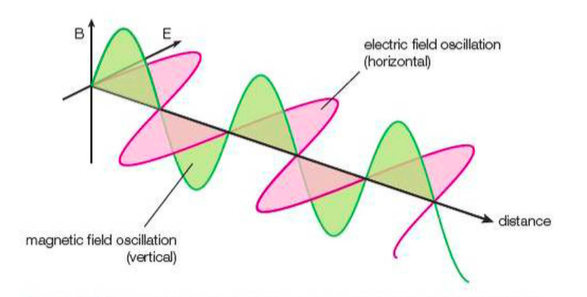
⇒ Mechanical waves need a medium to travel through and can travel as either longitudinal or transverse waves e.g. seismic waves
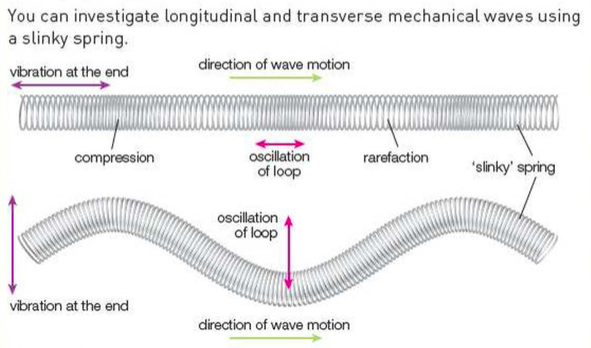
More about longitudinal waves
⇒ Sound waves are longitudinal waves produced by vibrations moving back and forth along the line of wave progression
⇒ This produces regions of high pressure (i.e. compressions) and low pressure (i.e. rarefactions)
⇒ The wavelength of a longitudinal wave is the distance between successive compressions or successive rarefactions
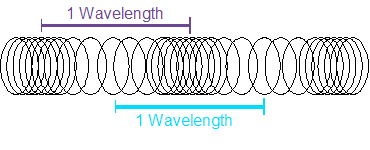
⇒ When sound travels in a solid, energy is transferred through inter-molecular or inter-atomic bonds
- Sound travels quickly in the solid because the bonds are stiff and the atoms are tightly packed
- In gasses energy is transferred by molecules colliding, so the speed of sound will depend on the speed of the molecules
- Sound waves are mechanical, so they cannot travel through a vacuum
Electromagnetic Waves
⇒ All electromagnetic waves travel at the speed of light and energy is carried by oscillating electric and magnetic fields
⇒ However, different electromagnetic waves have different properties depending on their wavelength

Effect of electromagnetic radiation on living cells
⇒ The effect depends on intensity, duration of exposure, and frequency of the radiation
- Radio waves, microwaves and infrared do not cause ionisation, but may have a heating effect
- Shorter wavelength electromagnetic radiation - such as UV, x-rays or gamma rays - are ionising
⇒ If a living cell absorbs ionising radiation, that may damage DNA molecules, which may result in mutations/cancer
- Radio waves have little effect on living cells
- In microwave ovens, water and fat molecules absorb microwaves well. This causes the molecules to vibrate, thus heating the food
- Molecules absorbing infrared radiation vibrate more, and therefore heat up more - hence why infrared can be used for cooking and heating
- We can see because light-sensitive cells in the retina at the back of our eye absorbs visible light
- Ultraviolet radiation absorbed by the skin can be tanned as melanin is produced in the cells. Exposure to UV raises the risk of skin cancer, but a person with more melanin (i.e. more tanned) is at less risk as the melanin can absorb UV reaching cells deeper in the tissue. Skin cells exposed to UV also produce vitamin D
- Gamma rays and x-rays are similar, but gamma rays come from radioactive decays, whereas x-rays are created when electrons strike a metal target. X-rays are used for medical imaging because they penetrate soft tissue but are absorbed by bones. High doses of radiation kill cells. Gamma rays are used in radiotherapy and to sterilise surgical equipment.
Communicating with electromagnetic radiation
⇒ Electromagnetic waves can be used to transmit information e.g. radios, tv, phones
⇒ When deciding which wave to use, you must consider how much of the wave will be absorbed by the atmpsphere or how much a wave will spread out due to diffraction
- Radio waves transmit TV and radio programmes by superimposing information from the programme on to a carrier wave by changing (i.e. modulating) the amplitude or frequency of the wave. A receiver converts the frequency of the wave to sound and images
- Some microwave frequencies penetrate the atmosphere and are used to communicate with satellites and mobile phone networks. Their wavelength is shorter than radio waves and diffract less, so transmitters and receivers need a straight line of sight
- Infrared and visible radiation can carry data in optical fibres. It is also used often for remote controls.
- Gamma rays, x-rays, and short wavelength UV does not penetrate our atmosphere, so space telescopes are needed to investigate these wavelengths in the universe
Polarisation
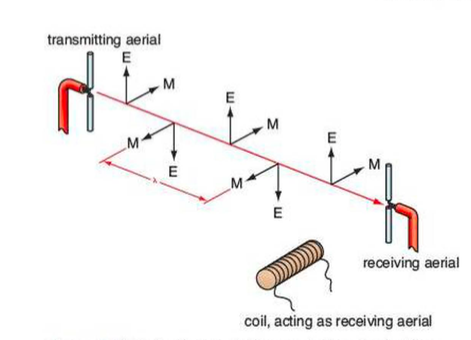
⇒ The above experiment can demonstrate polarisation
⇒ On the left there is a transmitting aerial that transmits 30cm radio waves and these are received by the receiving aerial on the right
⇒ A high frequency (1 GHz) is applied to the transmitting aerial, causing the electrons to vibrate up and down
- Therefore, the electrifc fields will only oscillate vertically (and the magnetic field will only oscillate horizontally)
- As the waves are only oscillating in one direction we can say that it is polarised i.e. the wave is vertically polarised because the electric fields are confined to the vertical plane
- Note how the polarisation is defined in reference to the electric field's oscillation
⇒ The receiving aerial in the diagram can receive the radio wave signal as it is placed vertically, allowing the electrons to oscillate up and down
⇒ However, if the receiving aerial was placed horizontally no signal would be detected because the electric field is in the wrong direction to make the electrons move along the aerial
Unpolarised
⇒ Light is an example of an unpolarised electromagnetic wave - since electrons in atoms can vibrate in any direction, the electric and magnetic fields of light oscillate in any direction too - so such light is unpolarised

⇒ In the following image, you can see unpolarised microwaves incident on a metal grille, which does not allow electrons to oscillate horizontally, so the waves emerge from the grille with their electric field purely verticaly

⇒ Polarisation is only a property of transverse wave as in longitudinal waves the wave always oscillates along the direction of energy transfer
Polarisation Effects
⇒ Light is polarised when passing through a polarising filter
⇒ Such a filter only allows electric field oscillations in one plane through the filter, because the filter absorbs all the energy from oscillations in all other planes

⇒ Polarised light is less intense than unpolarised light because only half the energy is transmitted through the filter
⇒ If a second filter is held at tright angles to the original filter (i.e. crossing the polarisers), all oscillations are blocked and no light is transmitted
⇒ Light can also be polarised ocassionally when reflecting from surfaces at some angles of incidence
Polarisation Applications
⇒ Polarising sunglasses are oriented to reduce the glare of the sun and can cut out light that has reflected from horizontal surfaces, such as water and snow
⇒ Outdoor tv and radio aerials must be correctly aligned to receive the best reception
- Transmitters send out plane-polarised electromagnetic waves, so the receiver must have the same alignment to pick up the signal
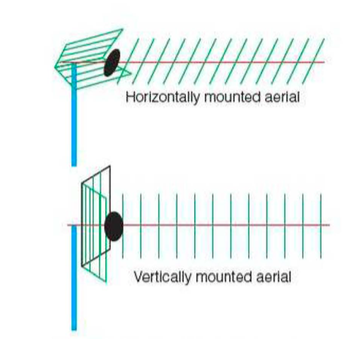
Extra
⇒ Also see our notes on: